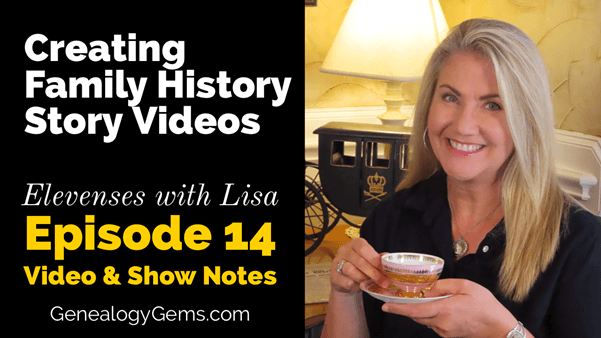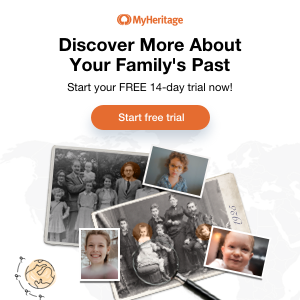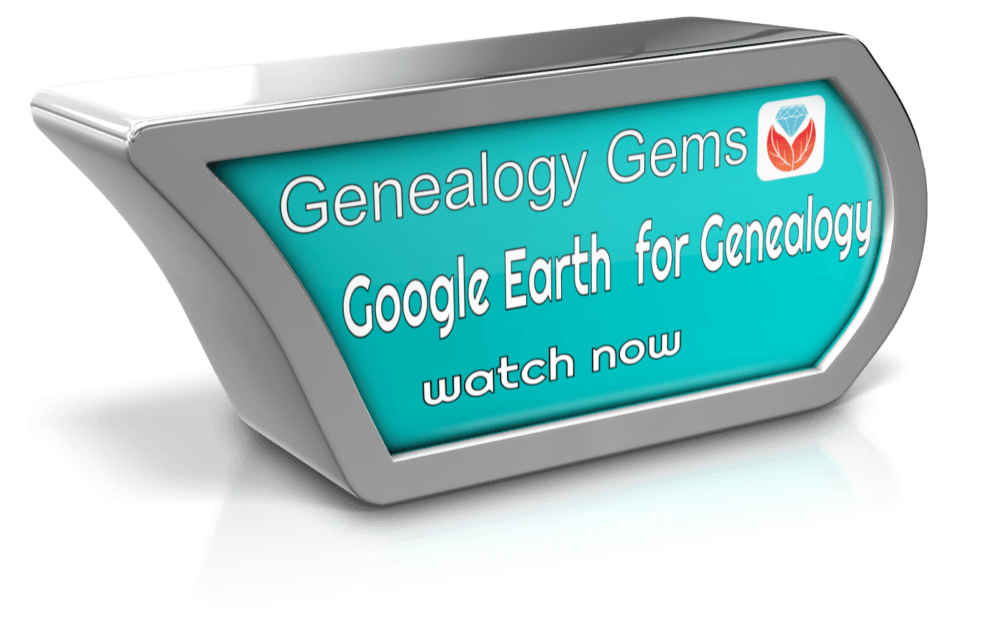Genealogy Gems Podcast Episode 245 – Telling Your Family’s Story with Video
with Lisa Louise Cooke
September 2020
Don’t just gather genealogical information. Take the time to tell your ancestors’ stories!
Video is the perfect medium for sharing your family’s history. It captures the interest of the eyes and the ears.
In this episode my special guest is Kathy Nielsen. She’s a librarian from California who recently started creating videos. She’s going to walk you through the simple yet effective process she followed. Then I will share additional things to consider and strategies that you can use.
If you’re not interested in creating a video, that’s OK. Today’s episode will make you a better storyteller and will provide you with inspiring story examples by other genealogists.
Elevenses with Lisa Episode 14 – Creating Family History Story Videos
Watch the video and read the full show notes here.
After listening to this episode, watch Elevenses with Lisa episode 16 How to Make a Video with Adobe Spark to learn how to make videos quickly and easily for free.
Genealogy Gems Premium Members can download the handy PDF show notes for each of these Elevenses with Lisa episodes. Simply log into your membership, and then in the menu under “Video” click “Elevenses with Lisa.” Click the episode and scroll down to the Resources section of the show notes.
Genealogy Gems Premium Members can download the show notes PDF from the Resources section on that page.
Become a Genealogy Gems Premium eLearning Member
Premium Members have exclusive access to:
- Video classes and downloadable handouts
- The Genealogy Gems Premium Podcast
- Elevenses with Lisa downloadable show notes PDF
Become a member here.
Getting Your Family History Digitized
I use Larsen Digital and have been extremely pleased with the service and results. The folks at Larsen Digital have put together special and exclusive discounts for Genealogy Gems listeners and readers. Click here to learn more and receive exclusive discounts and coupon codes.
Genealogy Gems Podcast App
Don’t miss the Bonus audio for this episode. In the app, tap the gift box icon just under the media player. Get the app here.
Sunday, September 27th. “The Irish philosopher and statesman Edmund Burke stated in 1790 that “People will not look forward to posterity who never look backward to their ancestors.” For those that do the looking forward, or those just idly curious about in their roots, today is Ancestor Appreciation Day. Census records play an important role in researching individual details, but the law mandates a 72 year wait for access. Annually, though, the Bureau’s American Community Survey compiles statistics for detailed ancestry or ethnic groups or populations in the nation. The largest reported ancestry is German, at over 41-million of our nearly 330-million population. The Irish of Edmund Burke come second, with nearly 31-million, or more than remain in Ireland itself.” Profile America
Stay Up to Date with the Genealogy Gems Newsletter
The Genealogy Gems email newsletter is the best way to stay informed about what’s available with your Premium eLearning Membership. Click here to sign up today.
Get Unlimited Photo Enhancement and Colorization at MyHeritage
Get genealogy records and unlimited Enhanced and Colorized photos as a MyHeritage PremiumPlus or Complete Plan Subscriber. Click here to start a free trial.
Follow Lisa and Genealogy Gems on Social Media:
Instagram.com/genealogygemspodcast
Facebook.com/genealogygems
Pinterest.com/lisalouisecooke
YouTube.com/GenealogyGems
Podcast Resources
Download the episode mp3
Download the show notes episode 245
Genealogy Gems Book Club: Q & A with Genealogist Nathan Dylan Goodwin, Author of The Sterling Affair
After a long day of genealogical research, what could be more satisfying than curling up with a good book about genealogical research?! Nathan Dylan Goodwin’s new book The Sterling Affair promises a satisfying return journey into the life of forensic genealogist Morton Farrier.
(This article includes affiliate links. If you decide to pick up a copy of this book, using our links for which we will be compensated by the book seller helps support our ability to bring author Q&A’s like this to your screen. Thank you!)
Click here to purchase your copy of The Sterling Affair
Goodwin sets the scene of his new book as follows:
“When an unannounced stranger comes calling at Morton Farrier’s front door, he finds himself faced with the most intriguing and confounding case of his career to-date as a forensic genealogist. He agrees to accept the contract to identify a man who had been secretly living under the name of his new client’s long-deceased brother.
Morton must use his range of resources and research skills to help him deconstruct this mysterious man’s life, ultimately leading him back into the murky world of 1950s international affairs of state.”
A Conversation with Author Nathan Dylan Goodwin
Don’t worry, we won’t be spoiling the exciting read you have ahead of you. Today I will be chatting with Nathan about his life as an author, his writing process, and how the main character, Morton Farrier, almost didn’t make it past the first book!
Lisa Louise Cooke: The Sterling Affair is your eighth novel in the Morton Farrier genealogical crime mystery series. When you first began writing the series did you imagine an eighth book? And today can you imagine even more?
Nathan: I literally had no concept that there would be so many books in the series! At first, it was written as a one-off, then I started to have ideas for two or three more.
I think when I wrote book three, The Orange Lilies, I knew that the series had plenty more scope, especially as DNA-testing was just beginning for genealogists, opening up a whole new world of potential storylines! As to the future of the series, I’m currently plotting books nine and ten. I don’t see an end to the series just yet!

Click the book image to order your copy.
Lisa Louise Cooke: I heard you speak at THE Genealogy Show conference in Birmingham England in 2019. In that presentation you told the audience that you almost killed off Morton at the end of the first book. I imagine you’re glad now that he survived. What exactly happened back then?
Nathan: Killing Morton would have been the most stupid thing I could have done!
I started writing Hiding the Past (the first book in the series) as part of my studies for a Master’s Degree in creative writing and I think I’d been reading a novel at the time, which went along the lines of ‘if you’re reading this then I’m dead’. I thought this angle might work for the first draft of my story but thankfully, as the book progressed, I was able to see several plotlines, which could continue into further stories.
I knew from the outset that I wanted the main character, Morton Farrier, to have been adopted and be totally unaware of his biological family, so there was plenty of scope there to continue that subplot in future books.
Lisa Louise Cooke: How has the advent of DNA testing changed the course of your writing?
Nathan: DNA-testing has completely changed the course of my writing—in a good way, I like to think! There are now so many more possibilities for Morton to solve his cases in different ways.
Morton took an Ancestry DNA test back in 2014 when it had not yet even become possible in the UK. He did what I had to do, which was to order one in the US and have a friend ship it over, then post it back to the US for testing and analysis!
From that point onwards, DNA has played an ever-increasing role in helping Morton to solve his cases. In the most recent book, The Sterling Affair, Morton uses a variety of real tools and websites which are familiar to genealogists.
Lisa Louise Cooke: When you start a book like The Sterling Affair, do you already have it well mapped out, or are there surprises even for you along the way as to the path it will take?
Nathan: I usually spend at least three months conducting research for the books. This involves reading, visiting record offices, libraries, churches, etc. Basically, anything which Morton does in the book, I do first.
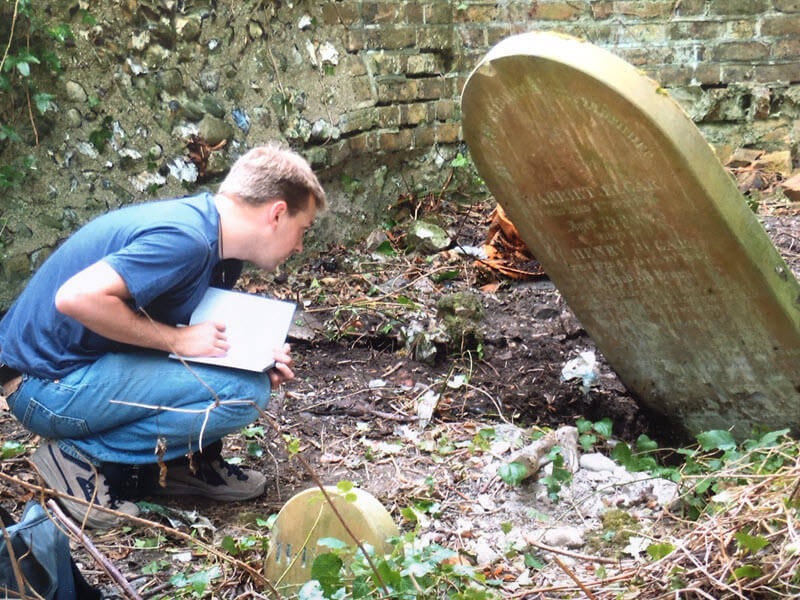
Photo courtesy of Nathan Dylan Goodwin
At the point when I actually start writing I probably have about 60% of the storyline mapped out. It’s a big cliché to say so, but for me the characters really do come to life and do things which I hadn’t anticipated. For the first few books I found it a little unnerving to be starting to write something that I didn’t know pretty well 100% what was going to happen, but now I trust myself and I know I’ll get to the end if I let the characters lead the way!
Lisa Louise Cooke: Where do you get your inspiration for the story lines in your books?
Nathan: My ideas come from a variety of sources, but never by actively searching for the next story; I just seem to stumble on a nugget of an idea, which I think could make for an interesting genealogical crime mystery and make a note of it! It can be a news story involving history or genealogy in some way, something I’ve picked up from a family history publication, or a Facebook group where people share their own genealogical mysteries.
Increasingly, the books have more real-life characters, plotlines and locations. For example, The Spyglass File, which is set on the frontline of Kent during the Battle of Britain, was loosely based on my grandmother’s story, whereby she gave birth to an illegitimate child in 1943, whom she put up for adoption whilst my grandfather was a POW in Thailand.

Nathan’s Grandmother – Photo courtesy of Nathan Dylan Goodwin.
The Sterling Affair is based on nefarious goings-on during the 1950s and involves real undercover MI6 operations and real spies. The idea for this story came from the National Archives newsletter, which mentioned the release of some previously closed MI6 records. This got me thinking about someone trying to conceal their real identity and Morton having to use his skills to work out who he might be!
Lisa Louise Cooke: For those new to your books, they will see that this is the eighth novel in the series and wonder if it’s too late to join in. Can the book be read and enjoyed as a stand-alone novel?
Nathan: I always say that the books can be read as a stand-alone, but you would be missing out on Morton’s backstory. However, with The Sterling Affair there is not too much given away about his own past, so, of all of the stories, this is the most readable out of sequence!
Lisa Louise Cooke: When you’re not writing about Morton Farrier, what is your favorite way to spend free time?
Nathan: I’m not sure what you mean by ‘free time’!? Obviously, I spend a lot of time on genealogy. I’ve been researching my own family for thirty years now and I feel very fortunate to be able to combine my two loves of writing and genealogy. Aside from that, I enjoy reading, running, skiing, theatre and spending time with my family, friends and dog.
Lisa Louise Cooke: You’re a man of many talents. Do you have other “wishlist” projects you yearn to do in addition to writing?
Nathan: I enjoy photography and would like to develop that at some point in the future and I really would like to take a watercolour painting class at some point. I just need some of that free time you mentioned!

A man of many talents – Photography by Nathan Dylan Goodwin
Lisa Louise Cooke: I’ll be at RootsTech again this year. Will we see you there?
Nathan: I shall have a booth at RootsTech SLC this year signing books and also at THE Genealogy Show in Birmingham once again. So people can come and say hello and let me know what they think of my stories. I love chatting with my readers!
Hear More from Nathan Dylan Goodwin
Read and hear more from genealogical author Nathan Dylan Goodwin in the following exclusive Genealogy Gems content:
- Genealogy Gems Podcast episode 180 features an Interview with Nathan Dylan Goodwin author of The Lost Ancestor.
- Genealogy Gems Podcast episode 179 features a discussion of The Lost Ancestor by Nathan Dylan Goodwin.
- Interview with Nathan Dylan Goodwin: Genealogy Gems Book Club – In this article from 2015 Nathan discusses the second book in the Morton Farrier series, The Lost Ancestor.
- Listen to the full-length Genealogy Gems Book Club interview with Nathan Dylan Goodwin, as he discusses The Lost Ancestor (The Forensic Genealogist) in Genealogy Gems Premium Podcast episode 125 (exclusive for Genealogy Gems Premium Members.)
- Listen to our interview with Nathan Dylan Goodwin about his The Wicked Trade and The Suffragette’s Secret in Genealogy Gems Premium Podcast episode 159 (exclusive for Genealogy Gems Premium Members.
Catch up on the Morton Farrier
Learn more about the entire book series featuring Morton Farrier here in this Genealogy Gems Book Club article.
Vintage NYC Street Views on Google Earth
You can now see New York City street views from the late 1800s and early 1900s as Google Earth street views. Take a virtual visit to the Big Apple as it was 100 years ago! Or travel back even further in time to an 1836 map of NYC conveniently overlaid on a modern Google Earth view. These are just two of the many ways to use Google Earth for genealogy—and for fun.
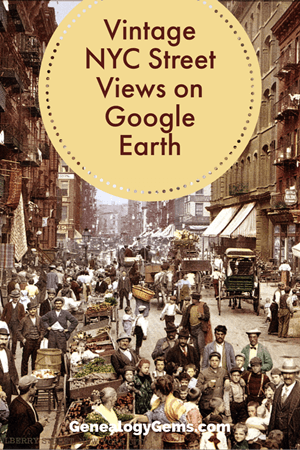
Vintage New York City Street Views on Google Earth
Over 80,000 original photos from the late 1800s and early 1900s have been mapped into Google Earth to provide what’s essentially a Google Street View map of old New York City!
The site is called OldNYC, and it’s free.
As you can see from this overview map (below), the old photos are concentrated in the areas of Staten Island, Brooklyn, Queens and Lower and Upper Manhattan. Dots represents historic photos that have been overlaid on Google Earth’s modern map (satellite view is also available).
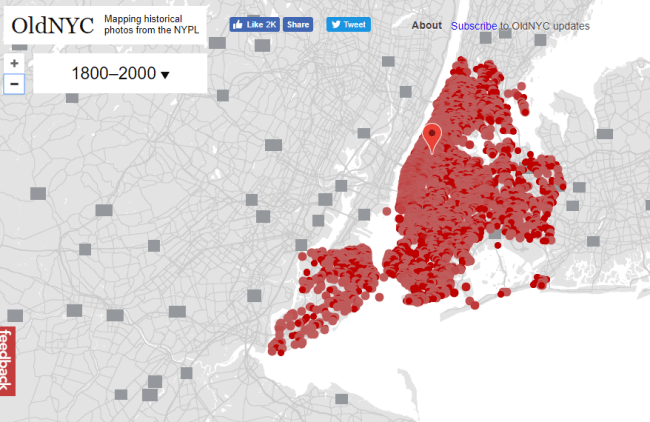
Old NYC
You can zoom in to click on individual dots, which will bring up one or more individual photos of certain neighborhoods or street fronts:
Select the photos that match up best with your family history interests, such as a shot of your family’s old store front or apartment building. Or choose images that represent the time period in which your relatives lived in the area, so you can get a flavor of what their neighborhood would have looked like. (Click here for some ideas about where to look for your family’s exact address during the late 1800s or early 1900s.)
These photos all come from the New York Public Library’s Photographic Views of New York City, 1870s-1970s collection, which is also free to view online.
According to this article at BusinessInsider.com, a developer Dan Vanderkam worked with the New York Public Library to plot all the photos onto Google Earth. (A hat-tip to Genealogy Gems listener and reader Jennifer, who sent me this article because she knows how much I love old maps and data visualization!)
Another Old NYC Street View: 1836 Map
While we’re on the subject, I also want to mention another cool tool for visualizing old NYC street views. At the Smithsonian.com, there’s a cool historic map overlay of an 1836 New York City map in Google Earth. Use the scrolling and zooming tools to explore the parts of NYC that were already settled–and to compare them to what’s there today. You can also swap views to see the 1836 map with just a little round window of the modern streets.
The accompanying article quotes famous map collector David Rumsey about the 1836 map, which is his. He describes how you can see that much of the topography of Manhattan has changed over the years—did you know Manhattan used to be hilly? And I love how he calls out artistic features on the old map, too.
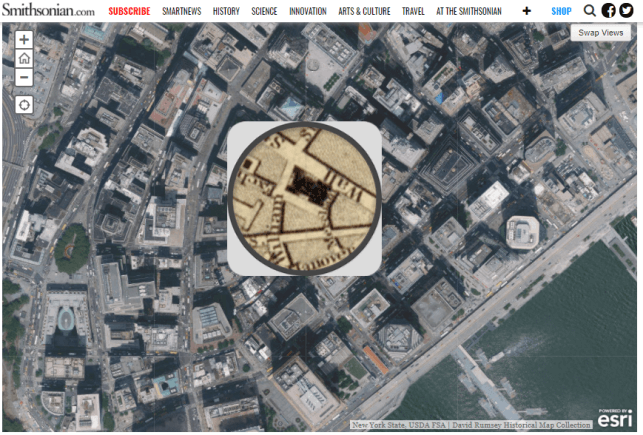
Smithsonian NYC street view 1836
Unfortunately, the old map doesn’t show much in the way of residents’ property lines or buildings. But you can clearly see the street layouts and where the parks and hills were. Comparing these areas with Google Earth’s street view today can help you better understand what things looked like in a much older version of one of the world’s great cities.
Use Google Earth for Your Genealogy
There are so many ways to use Google Earth for genealogy! My free video class will get you started. After a quick tutorial on downloading and navigating Google Earth, see how to utilize its powerful tools to identify an old family photo, map out addresses that may have changed and even plot an old ancestral homestead.
Click here to enjoy this free video!

